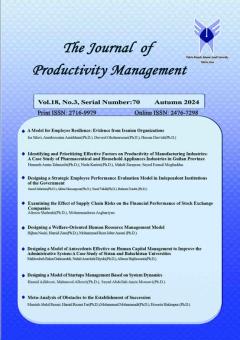الگویی برای تاب¬آوری کارکنان (شواهدی از سازمانهای ایرانی)
الموضوعات : governmental management
عیسی سیلاوی
1
,
امیرحسین امیرخانی
2
![]() ,
داود غلامرضایی
3
,
داود غلامرضایی
3
![]() ,
حسن درویش
4
,
حسن درویش
4
1 - دانشجوی دکتری، گروه مدیریت مدیریت دولتی، دانشگاه پیام نور، تهران، ایران
2 - دانشیار گروه مدیریت دولتی، دانشگاه پیام نور، تهران، ایران
3 - استادیار گروه مدیریت دولتی، دانشگاه پیام نور، تهران، ایران
4 - دانشیارگروه مدیریت دولتی، دانشگاه پیام نور، تهران، ایران
الکلمات المفتاحية: تاب¬آوری, کارکنان, صنعت نفت.,
ملخص المقالة :
هدف از پژوهش حاضر که یک پژوهش کاربردی از نظر هدف و توصیفی-پیمایشی از لحاظ روش است، ارائۀ الگوی تاب¬آوری کارکنان در شرکت ملی مناطق نفتخیز جنوب مستقر در اهواز می باشد. روال تحقیق به این شکل بود که با مرور ادبیات تابآوری کارکنان به روش فراترکیب ابعاد تاب¬آوری کارکنان احصا گردید. در مرحلۀ بعد با خبرگان به صورت هدفمند مصاحبه هایی صورت گرفت. بر مبنای نظرات خبرگان هفت بُعد برای تاب¬آوری کارکنان در جامعه مورد پژوهش استخراج شد. بر همین مبنا الگوی مفهومی تحقیق طراحی گردید. بر مبنای این مراحل پرسشنامهای جهت سنجش الگوی مورد نظر به صورت محقق ساخته طراحی گردید. برای بررسی پایایی پرسشنامه، از ضریب آلفای کرونباخ و برای بررسی روایی محتوایی آن، از نظر متخصصان مربوطه بهره گرفته شد. جامعه آماری تحقیق به تعداد 10000 نفر از کارکنان بوده که بر مبنای روش نمونه¬گیری تصادفی ساده، حجم نمونه 373 نفر تعیین شد. تحلیل داده ها با استفاده از نرم¬افزارهای SPSS22 و SmartPLS3 صورت گرفت. الگوهای اندازه¬گیری، ساختاری و کلی با بهره¬گیری از شاخص¬های برازش الگوها و فرضیه¬ها با استفاده از تحلیل مسیر، مثبت و معنادار گزارش شد.
Amiri, M., Alfat, L., Faizi, K., and Salehi Abarqaui, M.A. (2017). “Designing a model for organizational resilience”. Productivity Management, 11(44), 35-65 [In Persian]. dor:20.1001.1.27169979.1397.12.1.2.6.
Britt, T., Shen, W., Sinclair, R., Grossman, M., & Klieger, D. (2016). How Much Do We Really Know About Employee Resilience? Industrial and Organizational Psychology, 9(2), 378-404.
Caligiuri, P., De Cieri, H., & Minbaeva, D. (2020). International HRM insights for navigating the COVID-19 pandemic: Implications for future research and practice. Journal of International Business Studies, 51(5), 697–713.doi:10.1057/s41267-020-00335-9.
Cusack, L., Smith, M., Hegney, D., Rees, CS., Breen, L. J., Witt, R. R., Rogers, C., Williams, A., Cross, W., & Cheung, K. (2016). Exploring Environmental Factors in Nursing Workplaces That Promote Psychological Resilience: Constructing a Unified Theoretical Model. Frontiers in Psychology, 13(7):600. doi:10.3389/fpsyg.2016.00600.
Ferreira, R., Buttell, F., & Cannon, C. (2020). COVID-19: Immediate Predictors of Individual Resilience.Sustainability, 12(16),1-11. doi:10.3390/su12166495.
Hamid, M., Abdul Wahab, S., Hosna, A., Hasanat, M., & Kamruzzaman, M. (2020). Impact of Coronavirus and Employees’ Reaction to Changes on Employee Performance of Bangladesh. The International Journal of Business & Management.8(8),34-43. doi:10.24940/theijbm/2020/v8/ i8/BM2008-013.
Hartmann, S., Weiss, M., Newman, A., & Hoegl, M. (2019). Resilience in the Workplace: A Multilevel Review and Synthesis. Applied Psychology, 8(5), 69. 10.1111/apps.12191.
Hiebert, B. (2006). Creating a Resilient Workplace. Avilabale at: https://www.researchgate.net/publication/252104994_Creating_A_Resilient_Workplace.
Hosseini, A., & Jafari Baziar, F. (2019). “Organizational resilience from the perspective of employees and managers of the organization”. Scientific Quarterly Journal of Management Studies, 28(91), 9-30 [In Persian]. doi:10.22054/jmsd.2019.9658.
JokarTangKarami, B., Karimi, F., Nadi, M. A. (2021). A Model of Factors Affecting on Promoting the Resilience of Rotating Staff in Iranian Oil Terminals Company. Strategic studies in the oil and energy industry, 12(46), 203-218 [In Persian].
Mehranpour, M., Sayadi, S., Pourkiani, M., & Selajgeh, S. (2018). “Designing a human resource development model based on organizational values”. Iranian Management Sciences Quarterly, 13(13), 133-151 [In Persian].
Nastizaei, N., & Janabadi, H. (2015). “The relationship between organizational justice and positive organizational behavior and job enthusiasm”. Research in medical science education, 8(1), 12-21 [In Persian]. doi:10.18869/acadpub.rme.8.1.12.
Parsamehr, A., Moosavi, S., Soltani, H., & Sanaie, M. (2020). Factors Affecting Positiveness in Organizational Behavior at the Outbreak of Covid-19. medical journal of mashhad university of medical sciences, 63(2), 2498-2510.doi: 10.22038/MJMS.2020.19199
Paul, H., Budhwar, P., & Bamel, U. (2019). Linking resilience and organizational commitment: does happiness matter? Journal of Organizational Effectiveness: People and Performance. ahead-of-print. doi:10.1108/JOEPP-11-2018-0087.
Pilehvari, N., & Alizadeh, N. (2019). “Designing a human resources resilience management model in the conditions of the Corona epidemic based on Islamic teachings with fuzzy riding”. Qur'an and Medicine Quarterly, 5(4), 50-57 [In Persian].
Saadat Talab, A., & Jafari, M. (2020). “Analysis of the role of spiritual vitality in the relationship between social capital and social support with the resilience of employees against the epidemic of Covid-19 in the era of social distancing”. Psychological Health Research Quarterly, 14(1), 115-129 [In Persian]. doi:10.52547/rph.14.1.115.
Su. N, Tra. L, Huynh. H. T, Nguyen, H. H. & O’Mahony. B. (2021). Enhancing resilience in the Covid-19 crisis: lessons from human resource management practices in Vietnam. Current Issues in Tourism, 24(22), 3189-3205. doi:10.1080/13683500.2020.1863930.
Vella, Sh., C., Pai, N., B. (2019). A Theoretical Review of Psychological Resilience: Defining Resilience and Resilience Research over the Decades. Arch Med Health Sci, 7, 233-239. doi:10.4103/amhs.amhs _119_19.
Website of the Association of Organizational Health Psychologists at the Internet address: http://www.orghealth.co.uk.
Zhu, Y., Zhang, S., & Shen, Y. (2019) Humble Leadership and Employee Resilience: Exploring the Mediating Mechanism of Work-Related Promotion Focus and Perceived Insider Identity. Front. Psychol. 10,1-9. doi:10.3389/fpsyg.2019.00673.


